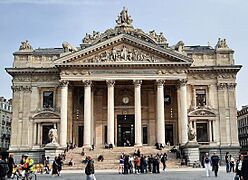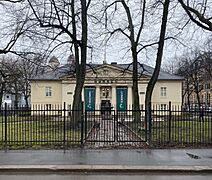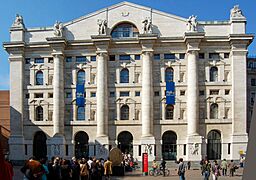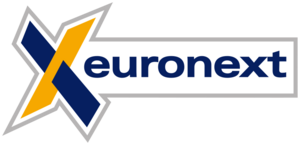Euronext facts for kids
 |
|

Euronext's registered office is located in the Euronext Amsterdam building, Beursplein 5, Amsterdam.
|
|
| Public | |
| Traded as | Euronext Paris: ENX CAC Next 20 Component |
| ISIN | [https://isin.toolforge.org/?language=en&isin=NL0006294274 NL0006294274] |
| Industry | Financial services |
| Founded | 1285 (as Huis ter Beurze) 1602 (as Amsterdam Stock Exchange) 1724 (as Paris Bourse) 22 September 2000 (present consortium) |
| Headquarters | Paris, France (operational headquarters) Amsterdam, Netherlands (registered office) |
|
Key people
|
Stéphane Boujnah (CEO & chairman of the Managing Board) |
| Revenue | 1,627 million (2024) |
| 620.684 million (2024) | |
|
Number of employees
|
2455 (2024) |
| Subsidiaries |
|
Euronext N.V. is a big European company. Its full name, European New Exchange Technology, tells you what it does. Euronext runs many important stock exchanges across Europe. It helps people buy and sell different financial things. Think of it like a huge marketplace for money and investments.
Euronext has its main office in Amsterdam, Netherlands. But its daily operations are run from Paris, France. It manages stock exchanges in seven countries. These include France (Euronext Paris), the Netherlands (Euronext Amsterdam), Belgium (Euronext Brussels), Ireland (Euronext Dublin), Portugal (Euronext Lisbon), Italy (Borsa Italiana), and Norway (Euronext Oslo Børs).
You can trade many things on Euronext. This includes company shares, special funds called ETFs, and even things like bonds. It also handles trading for goods like electricity and fish. By the end of 2023, nearly 2,000 companies were listed on Euronext. Their total value was about €6.6 trillion.
Euronext is the world's largest place for listing bonds and funds. It also offers technology services to other companies. Besides its main market, Euronext has special markets for smaller companies. These are called Euronext Growth and Euronext Access. Euronext Paris is the biggest part of Euronext. It makes up over 80% of the total market value. Euronext also helps trade important goods. It runs markets for power through Nord Pool and for fish through Fish Pool.
Euronext also provides services after trades happen. This includes "clearing" through Euronext Clearing in Rome. Clearing makes sure that trades are completed safely. It also offers "custody and settlement" services through Euronext Securities. This means it helps keep track of who owns what and makes sure payments are made.
The history of Euronext goes back a long way. Some of its roots are in very old trading places. These include markets in Bruges (1285), Antwerp (1485), and Amsterdam (1602). The Paris Bourse started in 1724. The Euronext we know today was created in September 2000. This happened when the stock exchanges in Amsterdam, Brussels, and Paris merged. The goal was to create one big, easy-to-use market for trading across Europe. Since then, Euronext has grown a lot. It now includes stock exchanges in many more European countries.
In August 2023, Euronext joined with 13 other exchanges to form EuroCTP. This group aims to create a "consolidated tape" for the European Union. This will make it easier to see all trading information in one place.
How Euronext Started
Early Stock Exchanges
-
Beurs van Berlage in Amsterdam, an old stock exchange building
-
The Palais Brongniart in Paris, once a stock exchange
-
The stock exchange building in Dublin
-
The stock exchange building in Oslo
-
Palazzo Mezzanotte in Milan
In 1998, some big stock exchanges wanted to work together. The London Stock Exchange and Deutsche Börse (from Germany) planned an alliance. They wanted to be stronger against competition. They also wanted to benefit from Europe's single currency, the euro. In April 1999, exchanges from Paris, Zurich, Madrid, Brussels, Amsterdam, and Milan also signed an agreement.
Forming Euronext in 2000
Only three exchanges decided to go ahead with the merger. On September 22, 2000, Euronext was officially formed. This happened when the Amsterdam, Brussels, and Paris stock exchanges joined together.
In 2001, Euronext itself became a publicly traded company. This means its own shares could be bought and sold. In December 2001, Euronext bought the London International Financial Futures and Options Exchange (LIFFE). This created Euronext.LIFFE. In 2002, Euronext also merged with the Portuguese stock exchange, which became Euronext Lisbon.
Joining with the New York Stock Exchange
In 2006, the NYSE Group, which owns the New York Stock Exchange (NYSE), offered to buy Euronext. This was a big deal, worth about €8 billion. Another German stock market, Deutsche Börse, also made an offer. But NYSE Group and Euronext decided to merge.
On April 4, 2007, the merger was completed. This created a new company called NYSE Euronext. This new company aimed to be the world's first truly global stock market. It planned to allow trading for 21 hours a day.
There were talks about NYSE Euronext merging with Deutsche Börse again in 2011. This would have created the largest exchange ever. However, European regulators blocked the deal in 2012. They worried it would create too much control in one company.
Becoming Independent Again
- Dutch ABN AMRO (0.52%)
- French Deposits and Consignments Fund (8.04%)
- Italian CDP Equity (8.04%)
- Belgium-based Euroclear Group (5.63%)
- Italian Intesa Sanpaolo (1.54%)
- Belgian Federal Holding and Investment Company (5.31%)
In 2012, another company called Intercontinental Exchange (ICE) decided to buy NYSE Euronext. This deal was worth $8 billion. ICE mainly traded goods like oil, while NYSE traded stocks. So, the deal was approved. ICE then decided to sell off the Euronext part of the company.
On June 20, 2014, Euronext became an independent company again. It did this through an "initial public offering" (IPO). This means its shares were sold to the public for the first time. To help Euronext stay strong, a group of eleven investors bought a large part of the company.
Since then, Euronext has continued to grow.
- In August 2017, it bought FastMatch, a currency trading platform.
- In March 2018, it bought the Irish Stock Exchange, which became Euronext Dublin.
- In June 2019, it bought the Oslo Stock Exchange.
- In December 2019, it bought most of Nord Pool, an electricity exchange.
- In April 2021, Euronext completed a big purchase of the Italian Bourse (Milan Stock Exchange). This made Euronext even bigger in European financial markets.
In November 2024, Euronext announced a new plan called "Innovate for Growth 2027." This plan focuses on growing its services beyond just trading. It wants to expand in areas like data solutions and technology. It also aims to be a leader in trading bonds, currencies, and goods. Euronext also plans to be the top market for ETFs in Europe. The company also set a goal to be "Net Zero" by 2027, meaning it will try to have no negative impact on the environment.
In July 2025, Euronext made an offer to buy the Athens Stock Exchange.
What Euronext Does
Trading Services
Where big European companies are listed (2021): Euronext: 28 (56%) Deutsche Börse (FWB/Xetra): 12 (23%) SIX: 6 (12%) Other (9%)
Euronext runs its main market where companies list their shares. It also has two special markets for smaller companies. These are called Euronext Growth and Euronext Access. They make it easier for small and medium-sized businesses to get listed.
Euronext uses a special computer system called Optiq for all its trading.
| Type of Market | Main Market | Markets for Smaller Companies | ||
|---|---|---|---|---|
| Market Name | Euronext | Euronext Growth | Euronext Access | |
| Number of Companies Listed | 776 | 229 | 180 | |
| Average Value when First Listed (€m) | Size | 278.1 | 22.8 | 0.1 |
| Total Market Value | 5,514 | 97 | 51 | |
| Where you can list (by city) | ||||
| Amsterdam | ||||
| Brussels | ||||
| Lisbon | ||||
| Dublin | ||||
| Milan | ||||
| Oslo | ||||
| Paris | ||||
Euronext also manages many important stock market indexes. These include national indexes for each country and larger European ones.
Trading Currencies
Euronext FX is a global platform for trading different currencies. It was known as FastMatch until 2019.
Trading Goods
Euronext allows trading in many physical goods. These include electricity (through Nord Pool), salmon futures (through Fish Pool), and farm products like wheat and corn.
Other Trading
Euronext also handles trading for other financial products. These include derivatives, bonds, and exchange-traded funds (ETFs). It is the largest place in the world for listing debt and funds.
After-Trade Services
Keeping Track of Securities
Euronext helps keep track of who owns what shares and bonds. It also makes sure payments are settled. It does this through its central securities depository (CSD), Euronext Securities. This service is based on Euronext's ownership of older national CSDs in Denmark, Italy, Norway, and Portugal.
Clearing Trades
Euronext also has a "clearing house" called Euronext Clearing. This company makes sure that all trades are completed safely and correctly. It was previously known as Cassa di Compensazione e Garanzia S.p.A. (CC&G).
Services for Companies
Euronext Corporate Services (ECS) is a part of Euronext. It was started in 2016. ECS offers solutions and services to over 4,000 organizations. These range from large companies to public sector groups. ECS has bought several companies that offer services like webcasting and compliance software.
Financial Information
| Year | Revenue | EBITDA | Net result |
|---|---|---|---|
| 2014 | €458,5 | €225,4 | €118,2 |
| 2015 | €518,5 | €283,8 | €172,7 |
| 2016 | €496,4 | €283,9 | €197,0 |
| 2017 | €532,3 | €297,8 | €241,3 |
| 2018 | €615,0 | €354,3 | €216,0 |
| 2019 | €679,1 | €399,4 | €222,0 |
| 2020 | €884,3 | €520,0 | €315,5 |
| 2021 | €1298,7 | €752,8 | €413,3 |
| 2022 | €1418,8 | €861,6 | €437,8 |
| 2023 | €1474,7 | €864,7 | €555,3 |
See also
 In Spanish: Euronext para niños
In Spanish: Euronext para niños
- Bourse of Antwerp, the world's first financial exchange
- Economy of the European Union
- Euroclear
- List of European stock exchanges
- List of stock exchanges











